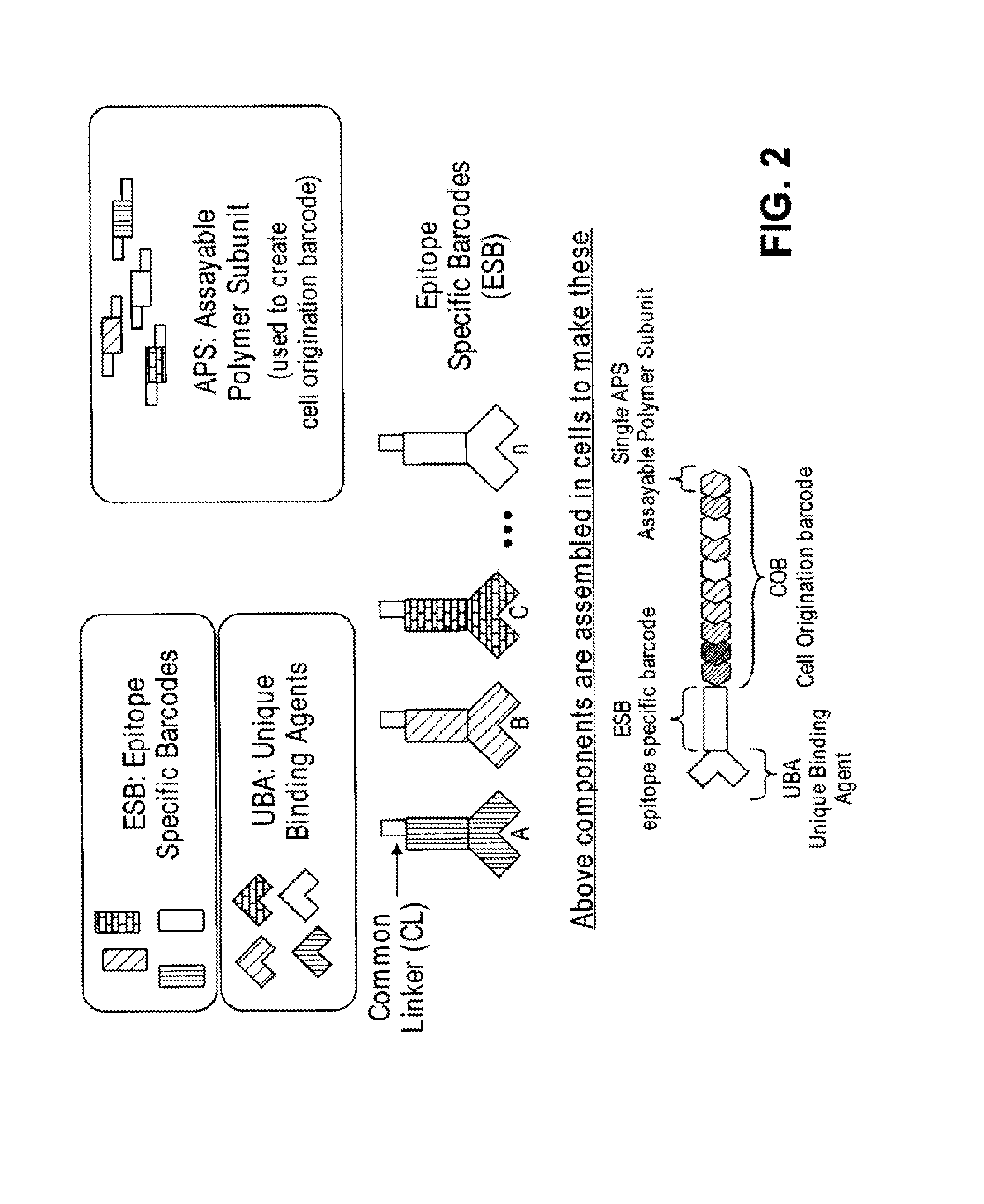Increasing dynamic range for identifying multiple epitopes in cells
a cell and epitope technology, applied in the field of increasing the dynamic range of cell epitope identification, can solve the problems of not providing cell specific information, requiring significant amounts of biological samples, and limited methods of multiplexed protein measurement technology
- Summary
- Abstract
- Description
- Claims
- Application Information
AI Technical Summary
Benefits of technology
Problems solved by technology
Method used
Image
Examples
##ic example 1
Prophetic Example 1
Oligonucleotide Preparation
[0293]Oligonucleotides can be synthesized according to standard techniques known in the art. For instance, oligonucleotides can be synthesized on a 394A DNA Synthesizer (Applied Biosystems Division of Perkin-Elmer Corp., Foster City, Calif.).
[0294]The oligonucleotides are purified by ethanol precipitation after overnight deprotection at 55° C. The primer-specific portions of the oligonucleotides used for PCR amplification are purified by polyacrylamide gel electrophoresis on 10% acrylamide / 7M urea gels. Oligonucleotides are visualized after electrophoresis by UV shadowing against a lightening screen and excised from the gel (Applied Biosystems Inc., 1992). They are then eluted overnight at 64° C. in THE (i.e. Tris-sodium EDTA) buffer (100 mM Tris / HCl pH 8.0 containing 500 mM NaCl and 5 mM EDTA) and recovered from the eluate using Sep Pak cartridges (Millipore Corp, Milford, Mass.) following the manufacturer's instructions.
[0295]Oligonucl...
##ic example 2
Prophetic Example 2
[0302]Oligonucleotide APSs are annealed to a template and kept overnight at 4° C. A solution of Cu′ click catalyst is prepared from tris-hydroxypropyltriazole ligand as described in Chan et al. (Chan T R, Hilgraf R, Sharpless K B, & Fokin V V (2004) Polytriazoles as copper(I)-stabilizing ligands in catalysis. Org. Lett. 6(17):2853-2855; 2.8 μmol in 0.2 M NaCl, 38.0 μL), sodium ascorbate (4.0 μmol in 0.2 M NaCl, 8.0 μL) and CuSO4.5H2O (0.4 μmol in 0.2 M NaCl, 4.0 μL). This solution is added to the annealed oligonucleotides and the reaction mixture is kept at 0° C. for 1 hr, then at room temperature for a further 1 hr. Reagents are removed using a NAP-25 gel-filtration column.
##ic example 3
Prophetic Example 3
Split-Pool Synthesis of COBs on Beads
[0303]In this Example COBs are synthesized attached to beads. 4 different methods are used for the assembly of APSs into COBs:
[0304]Patchwork COB (FIG. 6)
[0305]Aminomethyl macroporous polystyrene (MPPS) beads are labeled with ten different CL oligonucleotides, each with an optional first amplification primer complementary region, one of 10 different ESB sequences and a common annealing region. Six rounds of split pool synthesis are performed. In each round, beads are split into 20 different containers. A different oligonucleotide APS is added to each container, totaling 20 different APSs. Each APS in a given round further comprises a unique subcode sequence that is different from the rest of the APSs in that round.
[0306]In the first round, each APS comprises an annealing region 1 that is complementary to the annealing region of the CL oligonucleotide on one end and an annealing region 2 on the other end. Upon addition, the olig...
PUM
| Property | Measurement | Unit |
|---|---|---|
| volume | aaaaa | aaaaa |
| volume | aaaaa | aaaaa |
| time | aaaaa | aaaaa |
Abstract
Description
Claims
Application Information
 Login to View More
Login to View More - R&D
- Intellectual Property
- Life Sciences
- Materials
- Tech Scout
- Unparalleled Data Quality
- Higher Quality Content
- 60% Fewer Hallucinations
Browse by: Latest US Patents, China's latest patents, Technical Efficacy Thesaurus, Application Domain, Technology Topic, Popular Technical Reports.
© 2025 PatSnap. All rights reserved.Legal|Privacy policy|Modern Slavery Act Transparency Statement|Sitemap|About US| Contact US: help@patsnap.com



